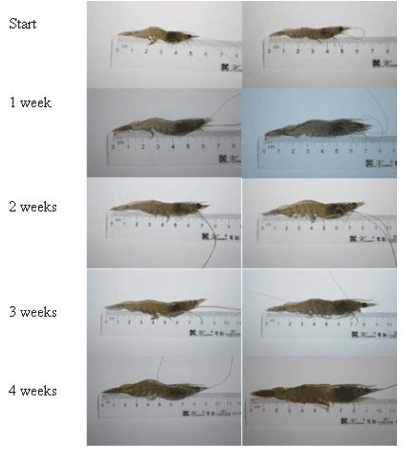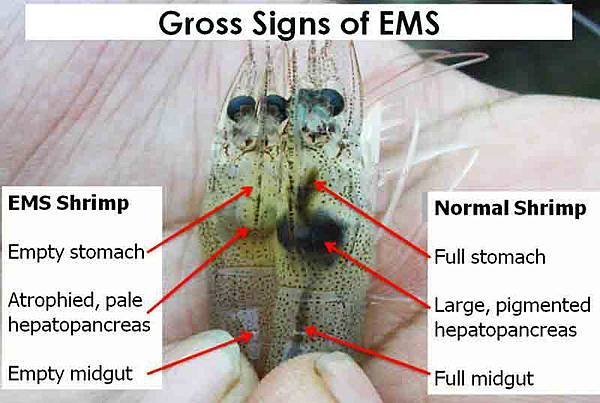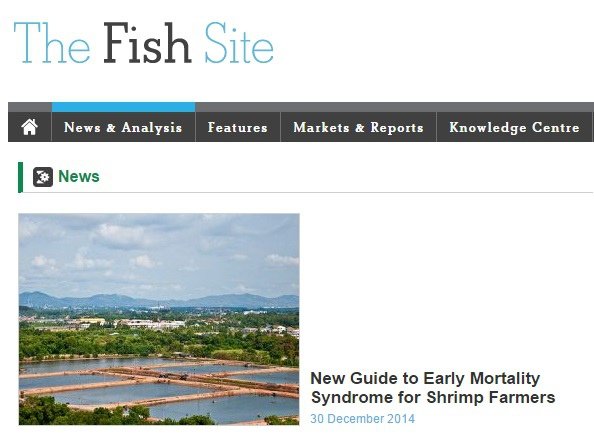EMS早期死亡綜合症新指南
以簡單的敘述點出早期死亡綜合症(EMS)的全貌,透過的疾病歷史、發病症狀和控制訪法提供蝦農最新的養殖指南。
Early Mortality Syndrome (EMS) 早期死亡綜合症 或 Hepatopancreatic Acute Necrosis Syndrome急性肝胰腺壞死綜合症是近年引起白蝦重大傷亡的疾病之一。
本病最早在2009年出現在中國,之後在2010年傳播到越南,2011年在馬來西亞和北婆羅洲,接著2012傳播到泰國。在2013年甚至首次傳播到亞洲以外的地區,因活蝦的輸出導致墨西哥地區也檢驗出EMS的感染。

經由亞利桑那大學的研究已確定這種疾病是由細菌帶源副溶血性弧菌(Vibrio parahaemolyticus),這是經腸道傳染並定植在蝦類中腸腺。之後產生毒素,引起組織破壞和肝胰臟功能障礙。
此外從近畿大學和日本國立水產養殖研究所的研究也確定了觸發EMS的原因。研究小組發現,EMS體現在池塘時,有以pH值有8.5-8.8的上升。

何時何地可能發生EMS?
該病迄今已證實在亞洲造成重大影響,並且影響到中國、馬來西亞、泰國和越南等養蝦場,在其他區也懷疑發生在墨西哥。
好發時間:放苗後的第7〜30天發病。

疾病診斷
EMS的特點是高死亡率,一般情況下放養30天內感染致死率達100%
EMS的臨床症狀包括:
1.蝦隻泳姿不穩定或停頓在池底部附近
2.蝦隻停止成長
3.肝胰腺的白化
4.肝胰腺變小
5.外殼變軟
6.肝胰腺呈現黑點或條紋
7.肝胰臟硬化

疾病控制及處理
1.選擇不帶病EMS的蝦苗,選育抗EMS抗病性高的品系做為種蝦。
2.加強養殖管理,消除水體EMS和其他病原體,建立平衡的微生物菌群,並密切管理水和底質。用氯消毒和臭氧消除多種病原體,建立一個穩定的養殖池菌像,益生菌和混養可以幫助管理。其他的建議如保持生物續團、避免過度餵食和定期去除污泥等。
3.採用育苗分階段放養。以較安全健康的環境培育蝦苗,直到蝦苗較大較強壯時,並且確定不帶EMS的病原在進入養殖池飼養。
4.改善養殖場的生物安全基礎設施。覆蓋塑膠膜或防鳥網,確保可控的危害因子。
5.使用飼料添加劑加強抗病力,以減少的EMS的發生率。包括維他命、精油或免疫增強劑。
6.需要綜合的養殖管理。避免養殖場間共享進排水水路,並考慮生態系統的承載能力。備有精良的實驗室,方便即時提供更好的EMS檢測。
網頁原文 http://www.thefishsite.com/fishnews/24649/new-guide-to-early-mortality-syndrome-for-shrimp-farmers

New Guide to Early Mortality Syndrome for Shrimp Farmers
GLOBAL - A newly updated Early Mortality Syndrome (EMS) disease guide gives the full picture of the disease including its history, symptoms and its control.
Early Mortality Syndrome (EMS) or Hepatopancreatic Acute Necrosis Syndrome is a fairly new disease that affects shrimp.
The disease was first seen in China in 2009, before it spread to Viet Nam in 2010, Malaysia and Northern Borneo in 2011 and Thailand in 2012. In 2013, EMS was reported for the first time outside Asia, showing up in Mexico - due to imports of infected live shrimps from Asia.
Research by the University of Arizona has identified that the disease is caused by the bacterial agent Vibrio parahaemolyticus, which is transmitted orally and colonises the shrimps gastrointestinal tract. This then produces a toxin that causes tissue destruction and dysfunction of the shrimp digestive organ known as the hepatopancreas.
A research team from Kinki University and the National Research Institute of Aquaculture in Japan, have also identified the trigger for EMS. The team found that EMS manifests in ponds when there is an increase in pH to 8.5-8.8.
When and Where Might it Occur?
The disease has so far been confirmed in Asia where it has affected farms China, Malaysia, Thailand and Viet Nam. The disease has also been suspected in Mexico.
The disease appears during the first seven to 30 days after planting.
Diagnosis
EMS is characterised by high mortalities, with many cases reaching 100 per cent within the first 30 days.
Clinical signs of EMS include:
- Erratic swimming or swimming near the bottom of the pond
- Reduced growth
- whitening of the hepatopancreas
- reduction in size of hepatopancreas
- Soft texture of the exoskeleton
- Dark spots or streaks on the hepatopancreas
- Hardening of hepatopancreas
Control/Treatment
- EMS-free broodstock are needed. Selective breeding for resistance to EMS would involve challenging families and selecting those with best survival as parents for the next generation.
- Improve farm practices. To eliminate EMS and other pathogens from water, establish a balanced microbial population, stock with healthy postlarvae and closely manage water and bottom quality. Disinfection with chlorine or ozone eliminates multiple pathogens. To create a mature microbial community, probiotics and polyculture can help condition water. Other suggestions were to maintain light to moderate bioflocs, avoid overfeeding and remove sludge regularly.
- Employ a nursery phase. Nurseries hold young postlarvae until they are larger and more robust, while also confirming they are free of EMS. Ten to 20 days in a nursery raceway, tank or net pen allows important physical and medical evaluations.
- Improve farm infrastructure with biosecure intensive ponds. Small, deep ponds covered with plastic or bird nets allow more manageable disinfection and feeding, as well as better control of water quality, bioflocs and sludge. Higher yields (30-50 mt/ha) can cover the extra investment.
- Identify feed additives that reduce the incidence of EMS. These could include quorum-sensing inhibitors, essential oils or immunostimulants.
- Integrated farm management is needed. Fragmented systems do not provide needed controls at each step in the production process. Zone management would avoid farm sitings with shared inlet and discharge canals, and consider the carrying capacity of ecosystems. Access to well-equipped local labs would provide better detection of EMS.




 留言列表
留言列表
 {{ article.title }}
{{ article.title }}